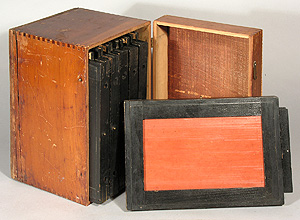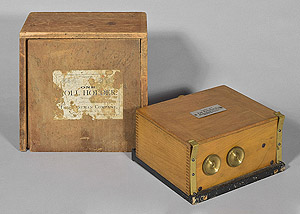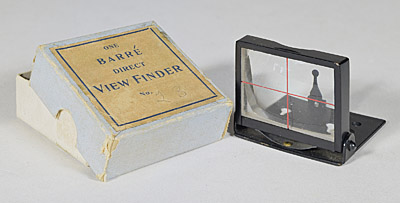Accessories for Wooden View Cameras
from the time period in which wooden view cameras were made: c.1850-1930
Cases
Many
cases came with the purchase of a camera - see
General Trends - Cases page.
A few were marketed separately as an accessory. These
after-market-type cases are shown here.
 |
Anthony's Brass Bound Canvas Carrying Case, E. & H.T. Anthony & Co., c.1880s-c.1890s |
Glass Plate Holder
Cases
Staple of the
dry-plate view camera. Cut film holders look identical. When
cut film started to be made, its size was standardized to dimensions
slightly smaller than the corresponding plate size. The reason was
so that a piece of cut film could be slipped into a metal sleeve ("kit")
that was exactly the same size as a glass plate, to allow the use of cut
film in glass plate holders.
Glass Plate Boxes
Once a photograph
was taken on a dry plate, it had to be stored somewhere. Wooden
boxes could be had for that purpose.
Plate Holders
Glass plates were
used c.1850 - c.1910, when cut film finally had the dimensional
stability to approach that of glass plates. For scientific
purposes, where precise measurement of dimension is crucial, glass
plates were widely used until quite recently, when they were supplanted
by digital detectors.
 |
Wet-Plate Holder, manufacturer unknown, c.1850-1870 |
Roll Film Holders
Roll film holders in the 1800's were mainly manufactured in sizes
from 4x5" to at least 8x10" (and probably larger by special order) by or
for The Eastman Kodak companies (Eastman Dry Plate & Film Co., The
Eastman Co., and Eastman Kodak Co.). The Blair Camera Co. also
manufactured two types of roll holders, one very similar to the Eastman
holders (probably by license), in 4x5" to fit their
Hawkeye
Detective Cameras, and one that is
large, heavy, and as unique as
many Blair products are. The heyday of roll film holders was
1886-1900. By 1901, Kodak had introduced the
Cartridge Roll Holder,
which could be loaded in daylight, a marked improvement over these
darkroom-bound versions. Cartridges were made in sizes up to 5x7".
Eventually, photographers preferred cut film holders, or, if they still
had glass plate holders, cut film adapters to fit in plate holders.
Because cut film had to fit into the adapter, it had to have slightly
small dimensions than the exact-dimensioned glass plates. This is
why cut film, even to this day, is one-eight of an inch short of its
nominal size, e.g., a piece of 4x5 cut film is 3⅞ x 4⅞".
Miscellany












































